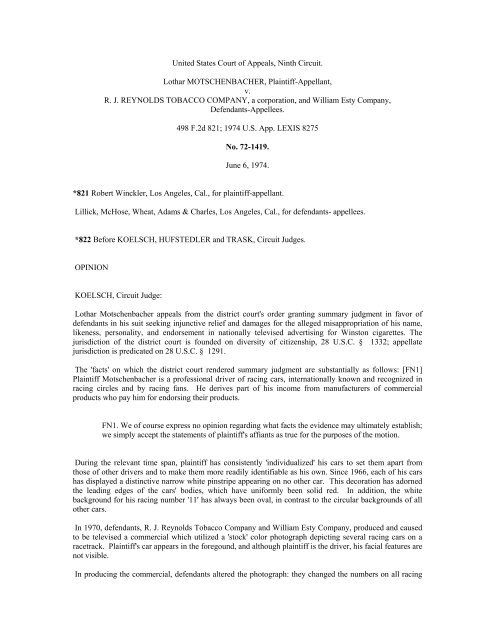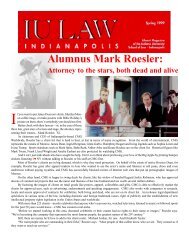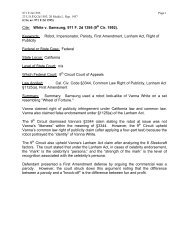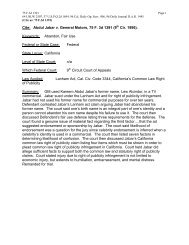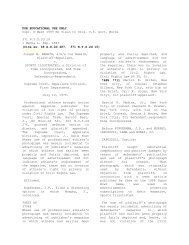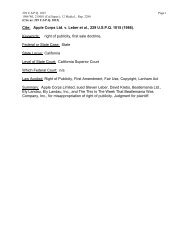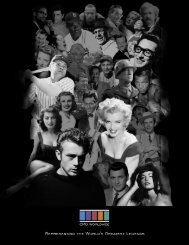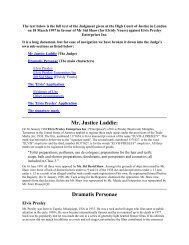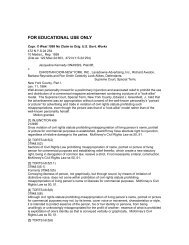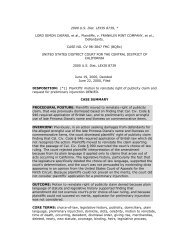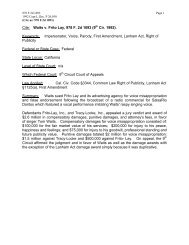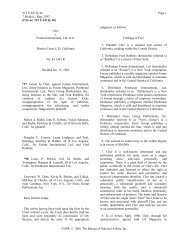Motschenbacher v. R.J. Reynolds Tobacco Company - Mark Roesler
Motschenbacher v. R.J. Reynolds Tobacco Company - Mark Roesler
Motschenbacher v. R.J. Reynolds Tobacco Company - Mark Roesler
Create successful ePaper yourself
Turn your PDF publications into a flip-book with our unique Google optimized e-Paper software.
United States Court of Appeals, Ninth Circuit.Lothar MOTSCHENBACHER, Plaintiff-Appellant,v.R. J. REYNOLDS TOBACCO COMPANY, a corporation, and William Esty <strong>Company</strong>,Defendants-Appellees.498 F.2d 821; 1974 U.S. App. LEXIS 8275No. 72-1419.June 6, 1974.*821 Robert Winckler, Los Angeles, Cal., for plaintiff-appellant.Lillick, McHose, Wheat, Adams & Charles, Los Angeles, Cal., for defendants- appellees.*822 Before KOELSCH, HUFSTEDLER and TRASK, Circuit Judges.OPINIONKOELSCH, Circuit Judge:Lothar <strong>Motschenbacher</strong> appeals from the district court's order granting summary judgment in favor ofdefendants in his suit seeking injunctive relief and damages for the alleged misappropriation of his name,likeness, personality, and endorsement in nationally televised advertising for Winston cigarettes. Thejurisdiction of the district court is founded on diversity of citizenship, 28 U.S.C. § 1332; appellatejurisdiction is predicated on 28 U.S.C. § 1291.The 'facts' on which the district court rendered summary judgment are substantially as follows: [FN1]Plaintiff <strong>Motschenbacher</strong> is a professional driver of racing cars, internationally known and recognized inracing circles and by racing fans. He derives part of his income from manufacturers of commercialproducts who pay him for endorsing their products.FN1. We of course express no opinion regarding what facts the evidence may ultimately establish;we simply accept the statements of plaintiff's affiants as true for the purposes of the motion.During the relevant time span, plaintiff has consistently 'individualized' his cars to set them apart fromthose of other drivers and to make them more readily identifiable as his own. Since 1966, each of his carshas displayed a distinctive narrow white pinstripe appearing on no other car. This decoration has adornedthe leading edges of the cars' bodies, which have uniformly been solid red. In addition, the whitebackground for his racing number '11' has always been oval, in contrast to the circular backgrounds of allother cars.In 1970, defendants, R. J. <strong>Reynolds</strong> <strong>Tobacco</strong> <strong>Company</strong> and William Esty <strong>Company</strong>, produced and causedto be televised a commercial which utilized a 'stock' color photograph depicting several racing cars on aracetrack. Plaintiff's car appears in the foregound, and although plaintiff is the driver, his facial features arenot visible.In producing the commercial, defendants altered the photograph: they changed the numbers on all racing
cars depicted, transforming plaintiff's number '11' into '71'; they 'attached' a wing-like device known as a'spoiler' to plaintiff's car; they added the word 'Winston,' the name of their product, to that spoiler andremoved advertisements for other products from the spoilers of other cars. However, they made no otherchanges, and the white pinstriping, the oval medallion, and the red color of plaintiff's car were retained.They then made a motion picture from the altered photograph, adding a series of comic strip-type 'balloons'containing written messages of an advertising nature; one such balloon message, appearing to emanatefrom plaintiff, was: 'Did you know that Winston tastes good, like a cigarette should?' They also added asound track consisting in part of voices coordinated with, and echoing, the written messages. Thecommercial was subsequently broadcast nationally on network television and in color.Several of plaintiff's affiants who had seen the commercial on television had immediately recognizedplaintiff's car and had inferred that it was sponsored by Winston cigarettes.On these facts the district court, characterizing plaintiff's action as one 'for damages for invasion ofprivacy,' granted summary judgment for defendants, finding as a matter of law that'. . . the driver of car No. 71 in the commercial (which was plaintiff's car No. 11 prior to said change ofnumber and design) is anonymous; that is, (a) the person who is driving said car is unrecognizable andunidentified, and (b) a reasonable inference could not be drawn that he is, or could reasonably beunderstood to be plaintiff, *823 Lothar <strong>Motschenbacher</strong>, or any other driver or person.' [FN2]FN2. The district court concluded:'3. Not having been identified in the commercial either visually, aurally, explicitly, or inferentially,plaintiff's action fails, and the Court is authorized to grant defendants' Motion for SummaryJudgment.''Summary judgment of course is proper only where there is no genuine issue of any material fact or whereviewing the evidence . . . in the light most favorable to the adverse party, the movant is clearly entitled toprevail as a matter of law.' See Stansifer v. Chrysler Motors Corporation, 487 F.2d 59, 63 (9th Cir. 1973),and cases cited therein.[1][2] Since the Winston commercial was broadcast on television throughout the United States, our initialinquiry in determining the correct legal standards to be applied on the motion for summary judgment isdirected at the proper choice of law. In a diversity case, a federal court must follow the substantive law ofthe state in which it sits. Erie R. Co. v. Tompkins, 304 U.S. 64, 58 S.Ct. 817, 82 L.Ed. 1188 (1938). Thisincludes the conflict of laws rules of that state. Klaxon Co. v. Stentor Electric Mfg. Co., 313 U.S. 487, 496,61 S.Ct. 1020, 85 L.Ed. 1477 (1941); Moore v. Greene, 431 F.2d 584, 589-590 (9th Cir. 1970).In this case, we believe that California courts, under Reich v. Purcell, 67 Cal.2d 551, 63 Cal.Rptr. 31, 432P.2d 727 (1967), would apply California local [FN3] law. [FN4] By the same taken, noting the novelty ofthe factual situation presented and recognizing that the parties have each cited general case law in supportof their respective positions, we think that California courts would not hesitate to consider relevantprecedent from other jurisdictions in determining California local law.FN3. We employ the definition of 'local law' set forth in Restatement (Second) of Conflict ofLaws, § 4 (1971), as follows:'[T]he 'local law' of a state is the body of standards, principles and rules, exclusive of its rules ofConflict of Laws, which the courts of that state apply in the decision of controversies broughtbefore them.'FN4. First, it appears that California, the state of plaintiff's residency, has a greater interest incompensating its residents for injuries of the type here alleged than other jurisdictions may have in
compensating foreigners so injured within their respective borders. Second, in cases of this type,the state of plaintiff's residency is normally the state of the greatest injury. Third, California, asthe forum, has an interest in convenience and presumably can most easily ascertain its own law.And fourth, California's Uniform Single Publication Act (Civ.Code § 3425.3) effectivelyadvances the universal interest in avoiding a multiplicity of suits and assisting the orderlyadministration of justice.[3] In California, as in the vast majority of jurisdictions, [FN5] the invasion of an individual's right ofprivacy is an actionable tort. Melvin v. Reid, 112 Cal.App. 285, 297 P. 91 (1931). [FN6] In 1960 *824Dean Prosser, drawing on over 300 cases, observed that the tort is actually a complex of four separate anddistinct torts, each of which is decided under an 'invasion of privacy' label. See Prosser, Privacy, 48Calif.L.Rev. 383 (1960); Prosser, Law of Torts 804 (4th ed. 1971). Prosser's four categories are: (1)intrusion upon the plaintiff's seclusion or solitude; (2) public disclosure of private facts; (3) placing theplaintiff in a false light in the public eye; and (4) appropriation, for defendant's advantage, of plaintiff'sname or likeness. [FN7] The case before us is of the fourth variety-- commercial appropriation. [FN8]FN5. Compare Time, Inc. v. Hill, 385 U.S. 374, 383 n. 7, 87 S.Ct. 534, 17 L.Ed.2d 456 (1967)(citing Prosser, Law of Torts 831-832 (3d ed. 1964), for the proposition that 'a 'right of privacy'has been recognized at common law in 30 States plus the District of Columbia and by statute in 4States'), with Prosser, Law of Torts 804 (4th ed. 1971) (observing that 'the right of privacy is bythis time recognized and accepted in all but a very few jurisdictions' and noting at 804 n. 16 sixjurisdictions recently added to the list.)FN6. See also Briscoe v. Reader's Digest Association, Inc. 4 Cal.3d 529, 93 Cal.Rptr. 866, 483P.2d 34 (1971); Carmel-By-The-Sea v. Young, 2 Cal.3d 259, 85 Cal.Rptr. 1, 466 P.2d 225 (1970);Kapellas v. Kofman, 1 Cal.3d 20, 81 Cal.Rptr. 360, 459 P.2d 912 (1969); Gill v. Hearst PublishingCo., 40 Cal.2d 224, 253 P.2d 441 (1953); Coverstone v. Davies, 38 Cal.2d 315, 239 P.2d 876(1952); Gill v. Curtis Publishing Co., 38 Cal.2d 273, 239 P.2d 630 (1952); Stilson v. Reader'sDigest Association, Inc., 28 Cal.App.3d 270, 104 Cal.Rptr. 581 (1972); Williams v. Weisser, 273Cal.App.2d 726, 78 Cal.Rptr. 542 (1969); Grimes v. Carter, 241 Cal.App.2d 694, 50 Cal.Rptr. 808(1966); Leavy v. Cooney, 214 Cal.App.2d 496, 29 Cal.Rptr. 580 (1963); Carlisle v. FawcettPublications, 201 Cal.App.2d 733, 20 Cal.Rptr. 405 (1962); Werner v. Times-Mirror Co., 193Cal.App.2d 111, 14 Cal.Rptr. 208 (1961); James v. Screen Gems, Inc., 174 Cal.App.2d 650, 344P.2d 799 (1959); Kelly v. Johnson Publishing Co., 160 Cal.App.2d 718, 325 P.2d 659 (1958);Smith v. National Broadcasting Co., 138 Cal.App.2d 807, 292 P.2d 600 (1956); Fairfield v.American Photocopy Equip. Co., 138 Cal.App.2d 82, 291 P.2d 194 (1955); 158 Cal.App.2d 53,322 P.2d 93 (1958); Stryker v. Republic Pictures Corp., 108 Cal.App.2d 191, 238 P.2d 670(1951); Cohen v. Marx, 94 Cal.App.2d 704, 211 P.2d 320 (1949); Kerby v. Hal Roach Studios, 53Cal.App.2d 207, 127 P.2d 577 (1942); Metter v. Los Angeles Examiner, 35 Cal.App.2d 304, 95P.2d 491 (1939).FN7. The California Supreme Court recognized Prosser's four-pronged system of classification inKapellas v. Kofman, 1 Cal.3d 20, 81 Cal.Rptr. 360, 459 P.2d 912 (1969), at 36 n. 16, though itthere suggested that a 'false light' cause of action in California is equivalent to, and meets the samerequirements of, a libel claim. See also Briscoe v. Reader's Digest Association, Inc., 4 Cal.3d 529,543, 93 Cal.Rptr. 866, 483 P.2d 34 (1971).FN8. In Fairfield v. American Photocopy Equip. Co., 138 Cal.App.2d 82, 291 P.2d 194 (1955),the California Court of Appeal observed at 86, 291 P.2d at 197:'The exploitation of another's personality for commercial purposes constitutes one of the mostflagrant and common means of invasion of privacy.'
California courts have observed that 'the gist of the cause of action in a privacy case is not injury to thecharacter or reputation, but a direct wrong of a personal character resulting in injury to the feelings withoutregard to any effect which the publication may have on the property, business, pecuniary interest, or thestanding of the individual in the community.' Fairfield v. American Photocopy Equip. Co., 138 Cal.App.2d82, 86, 291 P.2d 194, 197 (1955). But this observation is perhaps better applied to Prosser's first threecategories than it is to the appropriation cases.[4] It is true that the injury suffered from an appropriation of the attributes of one's identity [FN9] may be'mental and subjective'-- in the nature of humiliation, embarrassment, and outrage. Fairfield, supra, at 86,291 P.2d 194. However, where the identity appropriated has a commercial value, [FN10] the injury maybe largely, or even wholly, of an economic or material nature. [FN11] Such is *825 the nature of theinjury alleged by plaintiff.FN9. As Dean Prosser noted in his Law of Torts (4th ed. 1971), at 805-806:'It is the plaintiff's name as a symbol of his identity that is involved here, and not as a mere name.Unless there is some tortious use made of it, there is no such thing as an exclusive right to the useof a name; and any one can be given or assume any name he likes. It is only when he makes useof the name to pirate the plaintiff's identity for some advantage of his own * * * that he becomesliable. It is in this sense that 'appropriation' must be understood.'FN10. It would be wholly unrealistic to deny that a name, likeness, or other attribute of identitycan have commercial value. As the court observed in Uhlaender v. Henricksen, 316 F.Supp. 1277(D.Minn.1970), at 1283:'A name is commercially valuable as an endorsement of a product or for financial gain onlybecause the public recognizes it and attributes good will and feats of skill or accomplishments ofone sort or another to that personality.'See also notes 11 and 14, infra.FN11. Generally, the greater the fame or notoriety of the identity appropriated, the greater will bethe extent of the economic injury suffered. However, it is quite possible that the appropriation ofthe identity of a celebrity may induce humiliation, embarrassment and mental distress, while theappropriation of the identity of a relatively unknown person may result in economic injury or mayitself create economic value in what was previously valueless. In this latter context, see Canessa v.J. I. Kislak, Inc., 97 N.J.Super. 327, 235 A.2d 62, 75 (1967). See also Kalven, Privacy in TortLaw-- Were Warren and Brandeis Wrong?, 31 Law & Contemp.Prob. 326, 331 (1966); Bloustein,Privacy as an Aspect of Human Dignity: An Answer to Dean Prosser, 39 N.Y.U.L.Rev. 962, 985-991 (1964).Some courts have protected this 'commercial' aspect of an individual's interest in his own identity under aprivacy theory. See, e.g., Palmer v. Schonhorn Enterprises, Inc., 96 N.J.Super. 72, 232 A.2d 458 (1967);see generally Treece, Commercial Exploitation of Names, Likenesses, and Personal Histories, 51 TexasL.Rev. 637 (1973); Netterville, Copyright and Tort Aspects of Parody, Mimicry and HumorousCommentary, 35 S.Cal.L.Rev. 225, 253-254, 267-275 (1962); and Annotation, Invasion of Privacy by Useof Plaintiff's Name or Likeness in Advertising, 23 A.L.R.3d 865 (1969).Others have sought to protect it under the rubric of 'property' or a so- called 'right of publicity.' See, e.g.,Ettore v. Philco Television Broadcasting Corp., 229 F.2d 481, 485-493 (3d Cir. 1956), cert. den., 351 U.S.926, 76 S.Ct. 783, 100 L.Ed. 1456 (1956); Haelan v. Topps Chewing Gum, 202 F.2d 866, 868 (2d Cir.1953), cert. den., 346 U.S. 816, 74 S.Ct. 26, 98 L.Ed. 343 (1953), noted in Nimmer, The Right of Publicity,19 Law & Contemp.Prob. 203 (1954), 62 Yale L.J. 1123 (1953), and 41 Geo.L.J. 583 (1953); Uhlaender v.
Henricksen, 316 F.Supp. 1277, 1280-1283 (D.Minn.1973); Canessa v. J. I. Kislak, Inc., 97 N.J.Super. 327,235 A.2d 62 (1967). Cf. Cepeda v. Swift & Co., 415 F.2d 1205, 1206 (8th Cir. 1969) (dictum); O'Brien v.Pabst Sales Co., 124 F.2d 167, 170-171 (5th Cir. 1941) (dissent); Sharman v. C. Schmidt & Sons, Inc., 216F.Supp. 401, 407 (E.D.Pa., 1963) (dictum). See also Gordon, Right of Property in Name, Likeness,Personality and History, 55 Nw.U.L.Rev. 553 (1961).Prosser synthesizes the approaches as follows:'Although the element of protection of the plaintiff's personal feelings is obviously not to be ignored insuch a case, the effect of the appropriation decisions is to recognize or create an exclusive right in theindividual plaintiff to a species of trade name, his own, and a kind of trade mark in his likeness. It seemsquite pointless to dispute over whether such a right is to be classified as 'property'; it is at least clearlyproprietary in its nature. Once protected by the law, it is a right of value upon which the plaintiff cancapitalize by selling licenses.'Law of Torts (4th ed. 1971), at 807.[5][6] So far as we can determine, California has no case in point; the state's appropriation cases uniformlyappear to have involved only the 'injury to personal feelings' aspect of the tort. [FN12] Nevertheless, fromour review of the relevant authorities, we conclude that the California appellate courts would, in a case suchas this one, afford legal protection to an individual's proprietary interest in his own identity. We need notdecide whether they would do so under *826 the rubric of 'privacy,' [FN13] 'property,' [FN14] or 'publicity';[FN15] we only determine that they would recognize such an interest and protect it. [FN16]FN12. For example, in Kerby v. Hal Roach Studios, 53 Cal.App.2d 207, 127 P.2d 577 (1942),where an actress' name was appropriated in an advertisement which 'cast doubt on her moralcharacter,' the court spoke only of the traditional compensation for injury to her feelings. 53Cal.App.2d at 210, 127 P.2d at 580. Similarly, in Fairfield, supra, an attorney whose name,personality, and endorsement had been appropriated in an advertisement was compensated only'for injury to his peace of mind and to his feelings.' 138 Cal.App.2d at 88, 291 P.2d at 198. Andeven in the recent decision in Stilson v. Reader's Digest Association, Inc., 28 Cal.App.3d 270, 104Cal.Rptr. 581 (1972), the Court of Appeal reiterated that the injury in a privacy case is 'mental andsubjective.' 28 Cal.App.3d at 274, 104 Cal.Rptr. 581.FN13. Two recent decisions, Williams v. Weisser, 273 Cal.App.2d 726, 78 Cal.Rptr. 542 (1969),and Stilson v. Reader's Digest Association, Inc., 28 Cal.App.3d 270, 104 Cal.Rptr. 581 (1972),suggest that a 'commercial' interest in one's identity may be protected in California under the'privacy' rationale of Fairfield. In Weisser, a university professor brought suit for invasion ofprivacy and infringement of common law copyright when the defendant, without his consent,published student notes of plaintiff's classroom lectures under plaintiff's name. Plaintiff prevailedunder both theories and was awarded compensatory damages based on a publisher's testimony ofthe commercial value of the notes. In Stilson, the court noted that 'if commercial exploitation befound, (plaintiffs) would be entitled to nominal recoveries upon little more than an election toproceed' and that 'each such plaintiff has an established right to show the mental anguish, as wellas the financial detriment, which may have been caused to him by the use of his name in letters to* * * other persons. This * * * could well concern the status and business relationship to him ofthe recipients of the letters using his name.' 28 Cal.App.3d at 273-274, 104 Cal.Rptr. at 583.FN14. The interest may likewise be protectable as 'property.' In Yuba River Power Co. v. NevadaIrrigation District, 207 Cal. 521, 523, 279 P. 128, 129 (1929), a water rights case, the CaliforniaSupreme Court said in construing a statute: 'The term 'property' is sufficiently comprehensive toinclude every species of estate, real and personal, and everything which one person can own andtransfer to another. It extends to every species of right and interest capable of being enjoyed as
Defendant's reliance on Branson v. Fawcett Publications, Inc., 124 F.Supp. 429 (E.D.Ill.1954), ismisplaced. In Branson, a part-time racing driver brought suit for invasion of privacy when a photograph ofhis overturned racing car was printed in a magazine without his consent. In ruling that 'the photograph * ** does not identify the plaintiff to the public or any member thereof,' 124 F.Supp. at 433, the court said:'[T]he automobile is pointed upward in the air and the picture shows primarily the bottom of the racer. Thebackdrop of the picture is not distinguishable. No likeness, face, image, form or silhouette of the plaintiff orof any person is shown. From all that appears from the picture itself, there is no one in the car. Moreover,no identifying marks or numbers on the car appear . . .. Plaintiff does not even assert that the car he wasdriving was the same color as that which appears in the colored reproduction.'124 F.Supp. at 432.But in this case, the car under consideration clearly has a driver and displays several uniquelydistinguishing features.The judgment is vacated and the cause is remanded for further proceedings. [FN18]FN18. We have no occasion to discuss the measure of damages in the instant case, and ourconclusion renders consideration of whether plaintiff has a cause of action under the Californialaw of trade names or unfair competition unnecessary.


